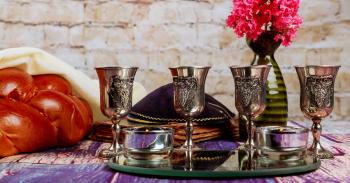
As one of Judaism’s central themes and considered holier than all other days of the week or year, save for Yom Kippur, much and more has been said about Shabbat. From the Torah providing two distinct reasons to keep the Shabbat (mentioned later on) and Shabbat being mentioned numerous times throughout the sacred texts, to the formation of countless Shabbat related symbols and artifacts and onto fervent scholarly and political debate spanning the ages (an entire tractate of the Talmud is dedicated to Shabbat). Up to this very day, there are few topics in Judaism that have captured our collective consciousness more than the last day of the week.
With such volumes of discussion, verbal and written, it’s quite natural that no-one person is familiar with it all. We are happy, therefore, to present to you, our readers, a few of Shabbat’s lesser known, but no less noteworthy surprises.
With that said, we thought to begin with a quick review of “Shabbat basics”. (Click here for Shalom House’s Shabbat section)
Exodus 20:7-9: “Remember the sabbath day, to keep it holy. Six days shalt thou labor, and do all thy work; but the seventh day is a sabbath unto the LORD thy God, in it thou shalt not do any manner of work, thou, nor thy son, nor thy daughter, nor thy man-servant, nor thy maid-servant, nor thy cattle, nor thy stranger that is within thy gates; for in six days the LORD made heaven and earth, the sea, and all that in them is, and rested on the seventh day; wherefore the LORD blessed the sabbath day, and hallowed it.”
Deuteronomy 5: “Observe the sabbath day, to keep it holy, as the LORD thy God commanded thee. Six days shalt thou labour, and do all thy work; but the seventh day is a sabbath unto the LORD thy God, in it thou shalt not do any manner of work, thou, nor thy son, nor thy daughter, nor […] And thou shalt remember that thou was a servant in the land of Egypt, and the LORD thy God brought thee out thence by a mighty hand and by an outstretched arm; therefore the LORD thy God commanded thee to keep the sabbath day.”
As with all of the 10 commandments, the 4th commandment regarding the Sabbath is restated twice in the Torah, once in Exodus and once in Deuteronomy. While the details of the divergence and the reasons for this repetition, topics of broad discussion, are beyond the scope of this article, we can say that the Exodus version concerns itself with the sanctity of Shabbat, and the Deuteronomy commandment drills down on the directive of refraining from work so that we may remember that we were slaves in Egypt and that God released us from this bondage. In the end of the day, the main takeaway is that the Sabbath is God’s day, and we need to treat it with the appropriate reverence.
Throughout the eons, a plethora of traditions have evolved around fulfilling the Shabbat commandment, each with its own special ceremonies and artifacts. The most well-known traditions include:
Preparing for Shabbat: As early as the 2nd century C.E., Jews started putting greater emphasis on preparing for Shabbat, with the sages telling us that “He who toils on the eve of Shabbat, will eat on Shabbat.” Shabbat is treated as an honored guest, and Fridays (even Thursday nights) in Jewish homes are dedicated to preparing for this guest. It is for this reason that we refer to Friday as “Erev Shabbat” (the “eve of Sabbat”).
Candle Lighting: Perhaps the most iconic of Shabbat ceremonies, lighting of shabbat candles originated, as best we know, in the first century B.C.E., although it wasn’t until the 14th century that it was established that two candles should be lit in honor of the twin Shabbat mitzvah’s of “Remember” and “Keep”. (Click here for our selection of Shabbat candles and candle holders).
Kiddush: Performing Kiddush on Shabbat and on Yom Tov is considered, by all accords, to be a mitzvah (i.e. commanded in the Torah). The Kiddush itself is composed of “sub-ceremonies” if you will, each with its own special observances:
Havdalah:
Marking the end of Shabbat and return to the “work week” (which, by the way, is also considered holy), Havdalah is one of Judaism’s most beautiful traditions. In addition to a blessing on the wine, the ceremony includes a blessing on a elegantly twisted candle, symbolizing the creation of light on the first day (in Judaism, Saturday night is the beginning of Sunday), and on spices, to help reinvigorate our souls after the departure of the “extra soul” given to us on Shabbat. (Click here for our selection of Havdalah sets).
The candles, spices and familial closeness of Havdalah give it a mystical air, making it the perfect segue into the next part of our discussion on less well-known tradition
Most of the aforementioned ceremonies and symbols are well known to Jews of all denominations, and to secular Jews as well, however, there are many, many more Shabbat traditions that are not quite as prevalent in our collective thinking. Some belong to a single region, city or even family, while others are denominational, and others yet existed only temporarily, fading out of Jewish custom for this reason or that. Be it as it may, these traditions may not be as familiar, but they are no less noteworthy or beautiful. Seeing as it would take dozens, if not hundreds of doctoral theses to adequately describe all of these traditions, we have chosen a few of our favorite to present here.
“Birkat Habanim” (The Children’s Blessing)
Birkat Habanim is a heartwarming blessing, given by parents to their children that is customary in a number of Jewish communities around the world. The ceremony involves the parents, together or one at a time, laying their hands upon each of the children’s heads and uttering the blessing which includes the priestly benediction. Many parents also add additional prayers and requests from God. The texts for the blessing are found in Numbers 6:23–27:
“Speak to Aaron and his sons, saying: This is how you shall bless the children of Israel:
‘May the Lord bless you and watch over you.
May the Lord cause His countenance to shine to you and favor you.
May the Lord raise His countenance toward you and grant you peace.’
They shall bestow My Name upon the children of Israel, so that I will bless them.”
The originator of the tradition is the celebrated rabbi and scholar, Judah Loew ben Bezalel, widely known as “The Maharal of Prague”, or simply “The Maharal”. The Maharal’s idea was for parents to leverage the “purity” of the extra soul given to us on Shabbat to the benefit of their children. Later scholars gave additional meaning to the blessing, such as Shabbat, being a happy time, undoes any harsh words said by parents during the week.
Dough Offering – הפרשת חלה (Hafrashat Challah)
The Torah commanded the Hebrews of old to set aside a portion of dough, prior to baking the bread, as an offering to the Temple priests. Today, without the benefit of the Temple, the custom amongst women wishing to uphold the Mitzvah is to burn the extra dough and then throw it out. With time, the mitzvah has morphed into something much more, where woman expand the simple act of dough offering to pray for the well-being of others. Today, you will find women of all denominations, and secular women as well, taking part in dough offerings to pray, for example, for the recovery of a sick friend or family member. While not directly related to Shabbat, it is connected not only in the use of Challah bread, but in the fact that both Shabbat and the dough offering are meant to sanctify the name of God.
“Kabbalat Shabbat” (Welcoming the Sabbath) in Israeli Kindergartens
Kabbalat Shabbat is originally part of the Friday Arvit service (Friday evening service) which includes special prayers, liturgical citations and verses from the Talmud and Zohar, but it has become much more than that, a specialized ceremony performed in schools, congregations and community centers around the world. Israel, has taken it one step further, making Kabbalat Shabbat a part of the kindergarten curriculum. In this context, Kabbalat Shabbat has become a means for making Shabbat a part of Israeli life from an early age, not only for observant Jews, but for all Jewish citizens of Israel.
In the kindergarten ceremony, a girl and a boy are appointed Shabbat “Imma” and “Abba” (mother and father, respectively), and they are responsible, with much help from the staff, for making a kiddush, and saying the “Motzih” on the challas (which are usually baked by the children themselves). It is a wonderous and wonderful site to see, if ever you have a chance to visit an Israeli kindergarten on a Friday morning.
We hope you have enjoyed learning about these traditions and tidbits of Jewish lore that often hide behind the Parochet (the curtain that covers Torah cabinets) and maybe you will adopt some as your own. Whatever you choose, we invite you to browse through our extensive selection of Shabbat artifacts to aid you in honoring the holiest day of the week.



